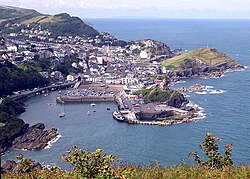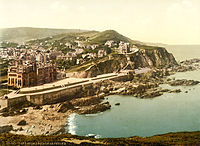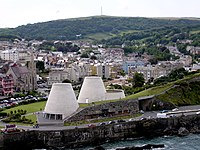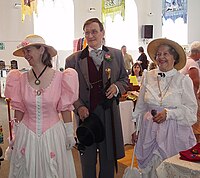Ilfracombe
| Ilfracombe | |
| Devon | |
|---|---|
 Ilfracombe from Hillsborough | |
| Location | |
| Grid reference: | SS516474 |
| Location: | 51°12’29"N, 4°7’12"W |
| Data | |
| Population: | 10,840 (2001) |
| Post town: | Ilfracombe |
| Postcode: | EX34 |
| Dialling code: | 01271 |
| Local Government | |
| Council: | North Devon |
| Parliamentary constituency: |
North Devon |
Ilfracombe is a popular seaside resort on the north coast of Devon. It is a town delightfully placed on a rounded promentary extending into the Bristol Channel, with a small harbour, surrounded by cliffs.
The parish stretches along the coast from 'The Coastguard Cottages' in Hele Bay toward the east and 4 miles along The Torrs to Lee Bay toward the west. The resort is hilly and the highest point within the parish boundary is at 'Hore Down Gate', 2 miles inland and 860 feet above sea level.
The landmark of Hillsborough Hill dominates the harbour and is the site of an Iron Age fortified settlement. In the built environment, the architectural-award-winning Landmark Theatre is either loved or hated for its unusual double-conical design. The 13th-century parish church, Trinity; and the St Nicholas's Chapel (a lighthouse) on Lantern Hill, have been joined by the Damien Hirst owned statue, Verity', as points of interest.
Contents
Geography
Ilfracombe lies within the North Devon Area of Outstanding Natural Beauty which is renowned for its dramatic coastal cliffs and landscape. Hillsborough, lying close to the town centre is a local nature reserve, The Cairn, and around the town are many other havens for wildlife.
The coast here is part of the North Devon Voluntary Marine Conservation area because of its diverse and rare species.
Geologically, the town overlies slates formed from sedimentary rock that underwent geological stress (creating faults and folds), towards the end of the Carboniferous Period, around 300 million years ago. These are known as the Ilfracombe slates.
Name
The town's name is of uncertain origin. The suffix "combe" is ultimately from the ancient British language, or Old Welsh, meaning "valley", though this word has long been used in English also; in Old English a cumb is a broad valley. One theory has it that the name "Ilfracombe" is based on the form Alfreinscoma by which name the town was noted in the Liber Exoniensis of 1086. Walter William Skeat of the University of Cambridge) reckons that it is derivative of ælfredingacumb: "Valley of the sons of Alfred". A second theory has it as yfel cumb: "Evil valley" or "valley with the bad ford".[1][2]
Churches
There are churches in the town serving various denominations in the town, including:
- Church of England:
- Holy Trinity
- St Peter's
- St Philip and St James
- Baptist: Ilfracombe Baptist Church
- Independent Evangelical:
- Brookdale Evangelical Church
- Ilfracombe Christian Fellowship Church
- Methodist/United Reformed Church: Emmanuel Church
- Salvation Army
- Roman Catholic: Our Lady Star of the Sea
History
Ilfracombe has been settled since the Iron Age, when a hill fort was built on the dominant hill, Hillsborough (once known as Hele's Barrow).
The manor house at Chambercombe in east Ilfracombe, was recorded in the 1086 Domesday Book as being built by a Norman knight Champernon (from Chambernon in France) who landed with William of Normandy. It is also said to be haunted.[3]
Ilfracombe was two distinct communities; a farming community around the parish church, Holy Trinity, parts of which date from the 12th century, and a fishing community around the natural harbour formed between Capstone, Compass and Lantern Torrs. It is recorded that the lands by the church were part of the estate owned by the Champernowne family those by the harbour to the Bouchiers, Earls of Bath.
Because of the natural layout of the harbour, Ilfracombe became a significant safe port (registered port of refuge) on the Bristol Channel. It also had trade routes between Kinsale and Tenby, which made the port stronger.
- In 1208 Ilfracombe was listed as having provided King John with ships and men to sail to Ireland.
- In 1247 it supplied a ship to the fleet that was sent to conquer the Outer Hebrides.
- 6 ships, with 79 men were sent to support the siege of Calais.
The building which sits on Lantern Hill by the harbour, known as St Nicholas's Chapel (built 1361) is reputed to be the oldest working lighthouse in the United Kingdom; a light/beacon has been there for over 650 years.[4]
The town was home to the Bowen family, a famed naval family. James Bowen was master of the HMS Queen Charlotte, the flagship of Richard, Earl Howe at the sea battle in 1794 known as "The Glorious First of June". James Bowen was commissioned by Howe for his leadership in the battle, he rose through the levels - commander of the Argot, the Dreadnought, and titled "defender of Madeira" he led the fleet which rescued the Army at Corunna in the Peninsula War. He retired as a Rear Admiral and a Commissioner of the Royal Navy. Captain Richard Bowen (1761–1797), James Bowen's younger brother, was a who served under Lord Nelson in the Terpsichore, and was killed at the battle of Santa Cruz de Tenerife. John Bowen (1780–1827), son of James Bowen, was a naval officer and colonial administrator; in 1803 founded the first settlement of Tasmania at Risdon Cove, later named Hobart.[5] Another local naval hero of the town was Lieutenant A E Down, who came to the town, posted to lead a Customs protection ship. He married a local girl, and rose through the levels to retire as Vice Admiral, his son joined the navy aged 14. His daughter was married to James Meek in 1802, a man who rose to be the Comptroller of Victuals to the Royal Navy in 1832, and who died in Ilfracombe 1852.
There was a wooden fortress overlooking the harbour, of this nothing remains except contemporary records and the area designated Castle Hill off Portland Street/Montepellier Terrace.
The novelist Fanny Burney stayed in Ilfracombe in 1817. Her diary[6] entries (31 July – 5 October) record early 19th century life in Ilfracombe: a captured Spanish ship; two ships in distress in a storm; the visit of Thomas Bowdler; and her lucky escape after being cut-off by the tide. A few years later in the 1820s a set of four tunnels were hand carved by miners to permit access to the beaches by horse-drawn carriage as well as by foot. Previously access was gained by climbing the cliffs, rounding the point by boat, swimming or at the lowest tides clambering around the rocks of the point. These tunnels led to a pair of tidal pools, which in accordance with Victorian morals, were used for segregated male and female bathing. Whereas women were constrained to a strict dress code covering up the whole body, men generally swam naked. The tunnels are still viewable and are signposted as Tunnels Beaches.
In 1856 writer the Mary Ann Evans (George Eliot) accompanied George Henry Lewes to Ilfracombe to gather materials for his work Seaside Studies published in 1858.
The town's first lifeboat was bought in 1828 but a permanent service was not available until the Royal National Lifeboat Institution built a lifeboat station at the bottom of Lantern Hill near the pier in 1866. The present station at Broad Street dates from 1996.[7]
Ilfracombe's fires
The Great Fire of Ilfracombe started at 12:40 am on the night of 28 July 1896 in the basement of Mr William Cole's ironmongers and furniture shop on the corner of Portland Street and Fore Street. The local volunteer fire brigade had it under control by the following morning. The firebrigade's entire equipment was a manual Merryweather engine, a hose-reel cart and one telescopic ladder on wheels. In total thirty five houses and business premises and their contents were destroyed. Later that year the fire brigade crew were presented with medals and £2 each at a dinner in their honour at the Royal Clarence Hotel. The damage was estimated at the times at between £80,000 and £100,000.[8]
The same area of the town was struck by fire twice during the 1980s. First on 12 December 1981 Draper's paint store in the upper story of the building on the corner of Portland Street and Fore Street, this fire was contained quickly, however fumes from the burning paint meant much of the local area was evacuated during the night. The second much larger fire started at 2:30am on the night of 2 September 1983 in the shopping arcade under the Candar hotel. In this fire one life was lost. Both of these fires drew parallels to the Great Fire in the media of the time. The Candar Arcade site became the Candar sheltered residential apartments (the opening of Candar apartments wa the last public engagement performed together by Prince Charles and Princess of Wales, in 1992.[9]
Other fires in Ilfracombe include: On 17 May 1985 the Beacon Castle was devastated by fire. On the 5 August 1991 the Mount Hotel was destroyed by fire. On 24 January 2001 the Hotel Cecil; 14 January 2004 the arcade on the seafront near Susan Day Residential Home was destroyed by fire. On 17 November 2004 and 13 February 2005 the Cliffe Hydro suffered from fires.
Shortly before 19:00 BST on Wednesday, 8 August 2006, a fire broke out at the derelict Montebello Hotel in Fore Street, Ilfracombe. Twenty fire engines were required to put out the blaze including a number rushed to the scene from Woolacombe, Barnstaple and the bordering county of Somerset. Specialist equipment was brought in from as far afield as Exeter, and according to the local radio news 85 firemen were involved at the fire. The fire spread to three neighbouring properties and showered debris over a wide area. The six-storey hotel was completely gutted, with only the front wall, chimney stacks and remains of the lift shaft frame surviving the blaze, and the fire was still being damped-down the following day. Fore Street was closed for some period due to the difficulties of demolition.[10]
The building was eventually demolished when it was determined that the fire had left it structurally unsound. This caused additional headaches for the emergency services as curious members of the public ignored safety barriers in an attempt to see the remains more clearly.[11] The site is to be redeveloped as residential accommodation, although, as of August 2009, no work has been started on the site.
This history of Ilfracombe's large fires has to be taken in the context of the number, size, and antiquity of many early Victorian jerry built hotels. A comprehensive display in the museum shows whilst the size of buildings may be large, the frequency of such conflagrations is comparatively low and the justification as to why Devon and Somerset fire and rescue authority transferred the large extension ladder from the Ilfracombe station to Barnstaple.
Economy
Ilfracombe's economy has always been founded upon the sea. Until the mid-19th century it was fishing and the port, importin goods and materials from as far as Africa and the West Indies. In the days of King George III the town was home to many navy personnel – four admirals, numerous captains, and other commissioned and non-commissioned sailors.
The town gradually developed into a tourist resort served by ferries along the Bristol Channel. The opening of the railway accelerated this development. The population grew until the First World War, then stabilised at 9,200, now 11,000. The economy suffered throughout the 1960s as holiday patterns changed, and suffered further through the closure of the railway line in 1970.
In the last 25 years, major investment by private light engineering companies has added to the economy. There are just 3 deep sea fishing boats which sail from the port but many inshore boats which harvest the local lobster, crabs and whelks. In a survey (2011) for EU funded Flag programme it was reported 90% of the local maritime catch is exported to France and Spain. There are many private charter, sea cruise, and coastal tour boat operators sailing from the harbour.
The High Street continues to thrive, despite the arrival outside the area of supermarket stores by large retailers. High Street businesses in 2010 include the major banks and building societies and small branches of many national or regional shop chains, but it still has traditional hardware stores and local butcher's, baker's, and florist's shops, which to some extent maintain its traditional individual character.
COMBEbusiness, a not-for-private-profit company, was established in April 2011 with the aim of promoting business around Ilfracombe, Woolacombe and Combe Martin. COMBEbusiness holds business events on the first Wednesday of each month and represents the town's businesses in dealings with councils, government and other bodies.
Ferry
The first steam packets arrived at Ilfracombe in 1823, and soon a regular service between Bristol and between Swansea developed.[12] On 16 May 1873, a wooden promenade pier was opened to allow the pleasure steamers to berth at all tides. On 23 June 1894, it was reported in the Ilfracombe Chronicle that over 2,500 people arrived in no less than seven boats, it describes them as 'commodious and well-appointed vessels with an excellent reputation for speed and comfort.' As well as holidaymakers, the boats carried workers, live and dead stock, and other merchandise to and from the town.[13]
The PS Waverley first arrived in Ilfracombe in 1887, after her owners Messrs P. and A. Campbell brought her to Bristol as their first pleasure steamer to work the Bristol Channel. Deterioration of the wooden pier and part demolition during Second World War mean that a new pier was required. The wood was replaced with reinforced concrete and car parking space was increased. The new pier was opened on 6 July 1952.
A seasonal passenger ferry, the MS Oldenburg, runs from the harbour to Lundy Island. Pleasure boats, including MV Balmoral and PS Waverley, operate cruises from Ilfracombe, including crossings to Porthcawl. However, due to rising fuel costs these services are under threat.[14]
A catamaran-based ferry service from Ilfracombe to Swansea has been proposed.
Sport
- Cricket: Ilfracombe Cricket Club, founded in 1923
- Football: Ilfracombe Town FC
- Golf: Ilfracombe Golf Club, founded in 1892
- Rugby: Ilfracombe Rugby Union Club, founded in 1877[15]
- Running: Hash Harriers Running Club
A tennis club is based at Bicclescombe Park which contains several tennis courts, bookable for a small fee by both tourists and locals.
The flat green bowling enthusiasts have a centre at the Ilfracombe bowling club on Highfield Rd.
In Fore Street, a table tennis centre with teams ranging in age from junior to veteran.
Sailing and the sea
Naturally there are maritime activities - based in a popular yacht club, a rapidly growing Gig boat club ( 3 x gig boats) which now competes in the world championships, and a kayak and canoeing club.
There is a large and thriving sub-aqua club.
There is a large sea fishing fraternity, both off shore using owned or hired boats, and shore casting from various beaches and "hot" spots.
Swim Ilfracombe to Swansea
The first person to swim the 30.5 nautical miles (35.1 statute miles) from Ilfracombe to Swansea was Gethin Jones, who achieved the record on 13 September 2009, taking nearly 22 hours.
Walking and cycling
Ilfracombe is at the northern end of National Cycle Network route 27, known as the Devon Coast to Coast Cycle Route, which starts from the pier (clock-in station at the Pier Tavern) and ends in Plymouth. There is another coastal trail suitable for cycling which starts at the pier which heads eastwards towards Minehead (defined as 'arduous'). A new event in 2010, organised by North Devon Wheelers is a giro cycle race round the town held as a prologue to the annual carnival. In September 2011 the first Ilfracombe triathlon was held on "the mother of all short courses" 400m sea swim, 22 km cycle, 5 km run - described as "lumpy".
The South West Coast Path connecting Minehead in Somerset to Dorset, by way of Land's End, passes through the town from Hele Bay to Lee Bay by way of Ilfracombe Harbour.
Big Society
There are thriving groups of volunteer led gardening and horticultural enthusiasts working together,for insurance and legal purposes,under the "Greener Ilfracombe" banner. Ilfracombe in Bloom group has successfully led the town in this national and regional competition for decades; since 2000 there have been developed 3 community gardens on underused or derelict land - Cow Green, a recreational garden, and Calf Green and Laston Green(small starter allotments); Trans-send, Devon Community Resource Cic (which operates the community apple orchard at Hele) are also affiliated. A new group to support English Heritage investigation into the historic importance of Hillsborough Iron Age settlement is formed.
Culture
Each year, the residents and school children of Ilfracombe celebrate their heritage. These celebrations include six carnivals - a May Day, led by a "green" man walking celebration, it is a successor to the May Day events held for centuries until suppressed by the church in the 19th century because of riotous, licentious, and drunken behaviour; Ilfracombe Victorian Celebration, a week-long programme of events held annually in June to celebrate a time of the town's prosperity; a large street carnival procession during August, organised by the St John's Ambulance service; the "sea ilfracombe" festival in September and the Lighting of the Lights held during November; and at Christmas, a Christingle.
A farmers' market is held regularly in the Lantern Community Centre on High Street. By the Landmark Theatre there is a small museum, housed in the buildings of the laundry of the former Ilfracombe Hotel. For those of literary intent there is an Ilfracombe authors'/writers' group.
The town hosts eight small art galleries, including the exhibitions displayed by the Art Society in the crypt of Emmanual Church on the seafront, the foyer of the Landmark Theatre, the Quay and in "Number Eleven, The Quay" within which there are many Damien Hirst works, including butterflies, pharmacy, small statues and wallpaper designs. In October 2012 Damien Hirst loaned the statue, Verity, to the District Council, it is a controversial piece but stands guiding mariners into the safety of the harbour. The town is home to many artists who work with Damien Hirst (winner Turner Prize for contemprory art 1996), of significance the 2011 short listed Turner Prize artist, George Shaw, has a studio and now lives in the town.
Two other charitable events are organised each summer by Ilfracombe Round Table. Both make use of Ilfracombe Pier as a display area. The first of these is the annual "South West Birdman" contest which involves entrants seeking to 'fly' from the pier in home-made flying machines. The second event is "Rescue Day", an opportunity for members of the public to learn about the activities of the emergency services. The highlight of the day is a simulated air-sea rescue involving the launch of the Ilfracombe RNLI lifeboat, a Sea King helicopter from RAF 22 Squadron, Exmoor Search and Rescue team and local Fire, Ambulance and HM Coastguard services.
Most Mondays and Thursdays the local Ilfracombe Sea Cadets meet near the harbour, in what was the old rope making factory on Ropery Road.
Performing arts
Studio Theatre is a community theatre group, established in 1984, which stages a wide variety of classic, musical, comedy and variety theatrical productions throughout the year at venues in Ilfracombe, including the Landmark Theatre, and throughout North Devon. Studio Theatre staged its 100th production, The Heiress, in May 2008. Through the 1990s, the town was also host to the now defunct National Youth Arts Festival.
Outside links
| ("Wikimedia Commons" has material about Ilfracombe) |
References
- ↑ Bowring (1931). Ilfracombe. pp. 16.
- ↑ Ilfracombe Official guide. 1935. pp. 1.
- ↑ The Legend of Chambercombe Manor
- ↑ Hoskins W.G (1954). Devon. Phillimore & Co Ltd. ISBN 1-86077-270-6.
- ↑ Bowen's Hobart: The Beginnings of European Settlement in Tasmania
- ↑ Fanny Burney. The Diary and Letters of Madame D'Arblay — Volume 3.
- ↑ Leach, Nicholas (2009). Devon's Lifeboat Heritage. Chacewater: Twelveheads Press. pp. 46–48. ISBN 978-0-906294-72-7.
- ↑ Images of England - Ilfracombe. Tempus. 2003. pp. 122, 123. ISBN 0-7524-2538-2.
- ↑ "An Ilfracombe Quiz". http://www.theilfracombecentre.co.uk/forum/viewtopic.php?f=2&t=91. Retrieved 21 July 2011.
- ↑ Initial report of the fire from BBC News
- ↑ "Report update". BBC News. 12 August 2006. http://news.bbc.co.uk/1/hi/england/devon/4787171.stm. Retrieved 20 February 2009.
- ↑ Images of England – Ilfracombe, 2003 (pub Tempus), ISBN 0-7524-2538-2
- ↑ Pocketts' Bristol Channel Steam Packet Company (pub Swansea Docks)
- ↑ Clark, Rhodri (27 June 2011). "All at sea? Future of steamer cruises from Welsh ports at serious risk". Western Mail. http://www.walesonline.co.uk/news/wales-news/2011/06/27/all-at-sea-future-of-steamer-cruises-from-welsh-ports-at-serious-risk-91466-28945962/. Retrieved 21 July 2011.
- ↑ Ilfracombe Rugby Union Club






